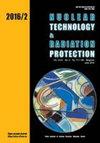Study on kinetic parameters characteristics of pebble bed reactor using HTR-proteus facility
IF 0.9
4区 工程技术
Q3 NUCLEAR SCIENCE & TECHNOLOGY
引用次数: 0
Abstract
The inherent safety feature of a pebble-bed reactor can be observed from its kinetic parameters. Proper modeling for calculating the reactor kinetic is also a concern for safe operation during normal and transient conditions. This study is intended to investigate the kinetic parameters characteristics of a pebble bed reactor using HTR-Proteus. A series of calculations were conducted using MCNP6 code and ENDF/B-VII library. The calculation results show that the negative value on core temperature reactivity is affected dominantly by the Doppler broadening effect. Prompt neutron lifetime l and mean generation time ? are slightly changed due to an increase in fuel temperature, moderator, and reflector that changed the neutron moderation and absorption over this part of the reactor. For (Th, U)O2, UO2, and PuO2 cores, the effective delayed neutron fraction ?eff values are more influenced by 233U, 235U, and 239Pu, respectively. In terms of stability during reactivity insertion, the UO 2 core is more stable and easier to control because its ?eff value is the largest compared to (Th,U)O2 and PuO 2 cores. It can be concluded that temperature must be controlled because it does not only affect the reactivity but also kinetic parameters as part of developing inherent safety features on the pebble-bed reactor.HTR-proteus装置球床反应器动力学参数特性研究
从球床反应器的动力学参数可以看出球床反应器的固有安全性。适当的模型计算反应堆的动力学也是一个安全运行的正常和瞬态条件下的关注。采用HTR-Proteus对球床反应器的动力学参数特性进行了研究。利用MCNP6代码和ENDF/B-VII库进行了一系列的计算。计算结果表明,堆芯温度反应性的负值主要受多普勒展宽效应的影响。提示中子寿命和平均生成时间?由于燃料温度,慢化剂,和反射器的增加,改变了中子的缓和和吸收,在反应堆的这一部分。对于(Th, U)O2, UO2和PuO2堆芯,有效延迟中子分数?eff值分别受233U, 235U和239Pu的影响较大。在反应性插入时的稳定性方面,UO 2核相对于(Th,U)O2和puo2核的?eff值最大,因此更稳定,更容易控制。温度不仅影响反应性,而且影响动力学参数,是球床反应器发展固有安全特性的一部分,因此必须加以控制。
本文章由计算机程序翻译,如有差异,请以英文原文为准。
求助全文
约1分钟内获得全文
求助全文
来源期刊

Nuclear Technology & Radiation Protection
NUCLEAR SCIENCE & TECHNOLOGY-
CiteScore
2.00
自引率
41.70%
发文量
10
审稿时长
6-12 weeks
期刊介绍:
Nuclear Technology & Radiation Protection is an international scientific journal covering the wide range of disciplines involved in nuclear science and technology as well as in the field of radiation protection. The journal is open for scientific papers, short papers, review articles, and technical papers dealing with nuclear power, research reactors, accelerators, nuclear materials, waste management, radiation measurements, and environmental problems. However, basic reactor physics and design, particle and radiation transport theory, and development of numerical methods and codes will also be important aspects of the editorial policy.
 求助内容:
求助内容: 应助结果提醒方式:
应助结果提醒方式:


